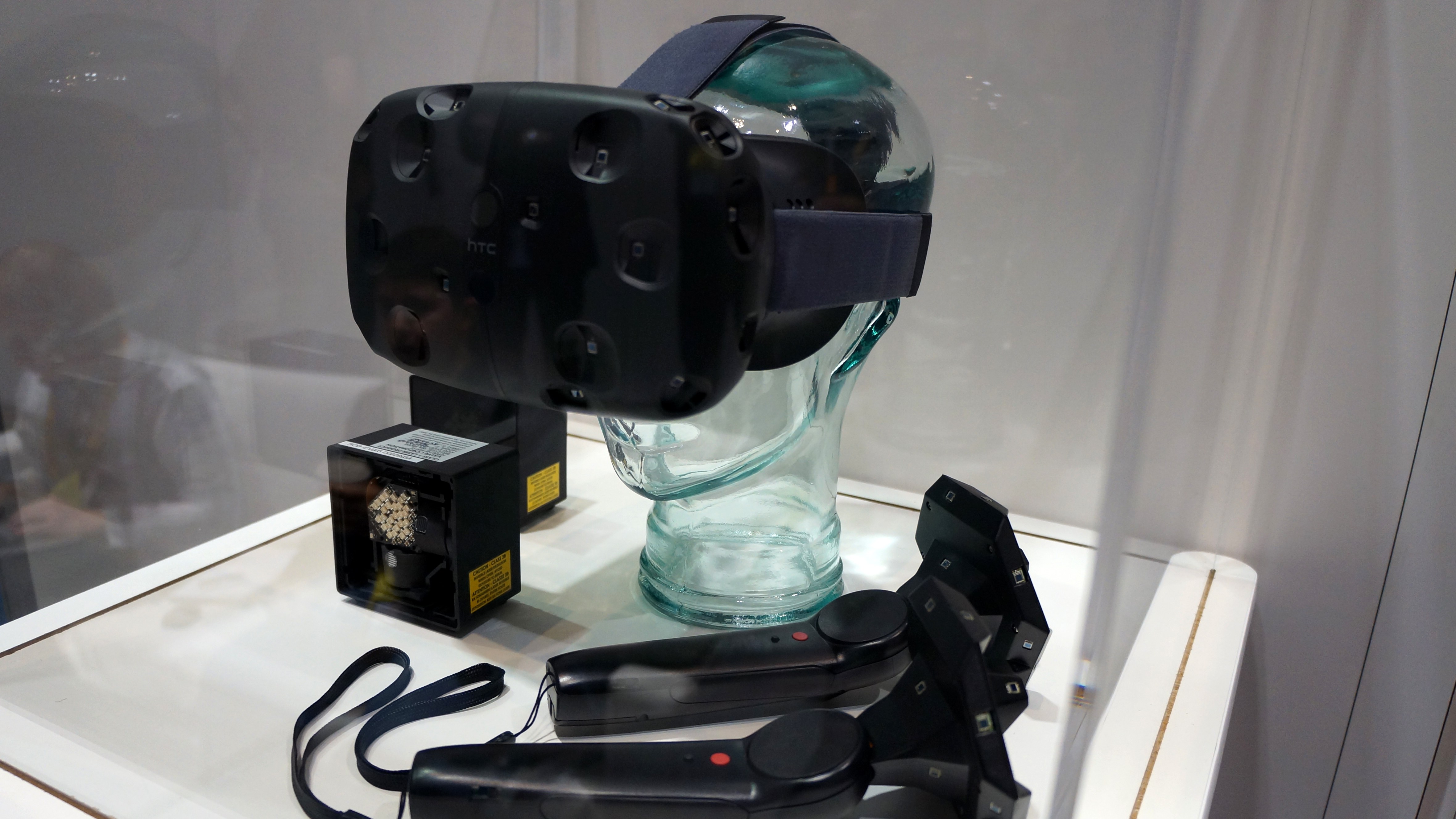

Tom Senior, web editor
Tom Senior will sacrifice almost anything for the VR dream, including his dignity. Especially his dignity.
Phil Savage, news editor
Phil Savage believes in pragmatic solutions to VR's physical limitations, and coincidentally hates moving too much when there's really no need.
In Face Off, PC Gamer writers go head to head over an issue affecting PC gaming. Today, Tom and Phil argue about the new capabilities HTC and Valve have added to their VR headset, revealed at GDC this week. Two “lighthouses” can track your movements through the room, letting you actually walk around virtual spaces. Is it pointless? Will it even work in the real world, where most people don’t live in empty holodeck cubes?
Tom Senior: YES. Physical movement is a vital part of the virtual reality fantasy.
I’ve used the Oculus Rift a lot now. It’s made for seated gaming, and while it’s still amazing, there’s a jarring conflict between your body’s stationary position and the audiovisual sense of movement you’re presented with. It’s one of the reasons I couldn’t play an FPS for more than five or ten minutes (though the notion of being seated in a cockpit, a la Eve Valkyrie, did alleviate things). I want the freedom to move physically through virtual spaces. If all it needs to work is a couple of little scanner boxes, then I’m in.
Phil Savage: NO. The laws of physics stop that fantasy becoming reality.
It's true, there's a disconnect between motion in VR and being seated in real life. My first Oculus experience was playing Half-Life 2, and every time Freeman jumped my brain did a tiny mental puke. Having a VR kit tuned for movement could solve this, and it's a beautiful dream, but boring reality means it can never be more than that. Put simply, my flat just isn't as big as City 17.
Tom: Let’s be honest. Even if it’s impossible, it’s the Star Trek holodeck fantasy we’re chasing here. Perhaps we’ll never be able to go full Star Trek, like when they ride horses around medieval worlds contained inside what’s really a medium-sized room. I don’t care. We should get as close as we feasibly can, and Valve and HTC’s spatial mapping looks like a significant step in the right direction, if you’ll forgive the pun.
Phil: Does that holodeck fantasy include the bit where the safety protocols fail and the ship's computer generates a sentient Moriarty intent on killing everyone? Admittedly that'd be cool, but it feels like we're heading towards the VR equivalent of the uncanny valley. The closer we come to realising the fantasy, the more disappointing it'll be when we fall short. Wes's preview describes reaching the edge of a real-life wall and seeing a neon blue safety grid appear. That's not the holodeck, that's Assassin's Creed's animus. And even that let you sit down.
The biggest gaming news, reviews and hardware deals
Keep up to date with the most important stories and the best deals, as picked by the PC Gamer team.
Tom: Alas, if there’s an episode where Picard runs full-tilt into the wall of the holodeck, I have not seen it. It’s true that there are major barriers still to overcome, and it’s becoming increasingly clear that you can’t just plug existing games into VR headset. VR is a new platform that demands new game design. It’s up to designers to work around the limitations of physical space. Here’s a Valve engineer talking about how they’re getting their game designers to create brand new prototypes based on the headset’s capabilities. “You can only walk around in a small area physically, but I can play with scale, I can play with velocity, I can teleport, I can do all sorts of stuff. We’ve used a dozen different techniques to move you around in a game world.” The engineer compares VR to the early days of game design in the ‘80s, when there were no rules or genres to adhere to. That’s hugely exciting. Getting axed in the face by a rogue Moriarty is surely a small price to pay for that.
Phil: Do you really want the VR equivalent of Manic Miner? I doubt there are enough psychiatrists in the world to cope. But space isn't the only issue with Valve's VR plan. The main question I ask of any VR device is how much of a bellend will I look while using it? With the Oculus, the answer was quite a bit of one. My lingering memory of the DK2 isn't of being immersed in an unbelievable world; it's watching Andy gasp in wonder at Chris's crotch. In his private world, he was seeing beauty. In the real world, it was his co-worker's ball zone. At least the Oculus doesn't require you to move through a reality you can no longer see. Under Valve's new system, we're at risk of accidental groping, low hanging light fittings, and small pets unaware that you're fleeing an axe-wielding super genius in a cravat.
Tom: Yes, VR will be a lonely experience, but an awesome lonely experience, and so what if you look like an invader from a horrifying science fiction universe, you’ll be too busy killing alien invaders in your own personal science fiction universe to care. There are things we're going to have to sacrifice to achieve the quality of VR that we deserve, and the sanctity of ball zones may be one of them.
I guess I’m going to have to pull out the big guns, in this case a clip of the seminal British kids’ show, Knightmare, a primitive imagining of a kind of proto-VR experience that also involved a stupid hat. Knightmare was ostensibly a trippy trust exercise for polite British teens, but let’s look past the slightly depressing reality of that for a moment and address the fantasy that Knightmare represents, which is the freedom to walk around the world looking like a total plonker in a way that doesn’t matter as long as you’re having fun. And you can’t deny that VR won’t be fun, can you? Can you?
Phil: Damn it! Invoking Knightmare? That's cheating!
Fine, in very specific circumstances, this VR plan will probably work. For instance, when blind in a dungeon, being guided by your friends as you answer a riddle for a wall for the amusement of a slightly bitter Shakespearian actor. Probably other situations too—Valve seems to have some ideas for specific scenarios that can be custom designed for the device. They also have a Portal demo. That's a high-risk application. I can just about picture flinging myself through its puzzles while strapped firmly into my seat. Standing up? You guessed it: falling over in a shower of vomit. Maybe it is the VR future, but it's one that'll need a lot of mops.
Tom: On that point I can only agree, which is why it's a good thing that the first game announced for Valve VR is job simulator, the perfect preparation for our vom-filled future.
PC Gamer is the global authority on PC games—starting in 1993 with the magazine, and then in 2010 with this website you're currently reading. We have writers across the US, Canada, UK and Australia, who you can read about here.


